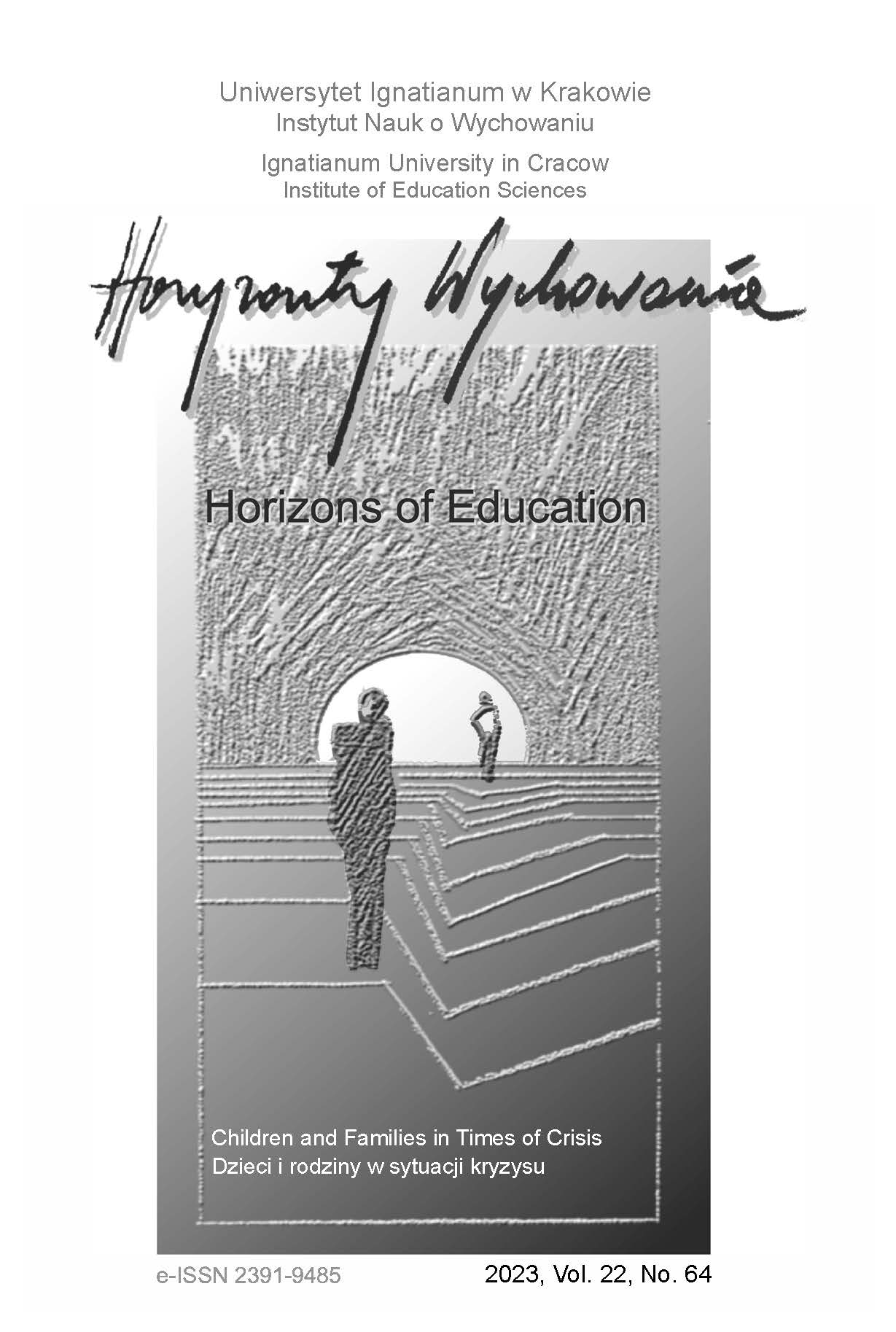Protecting and Educating Children on the Move in UNICEF and UNHCR Documents
Abstrakt
CEL NAUKOWY: Celem artykułu jest pokazanie na podstawie dokumentów UNICEF i UNHCR problemów dzieci migrantów i uchodźców, które utrudniają/uniemożliwiają im włączenie się do edukacji społeczeństw przyjmujących, oraz podpowiedzi, jak im zaradzić.
PROBLEM I METODY BADAWCZE: Wykorzystując analizę dokumentów, odpowiem na pytania: Na jakie zagrożenia narażone są „dzieci w ruchu”? Jakie są obszary priorytetowych działań? W jaki sposób można je chronić oraz włączyć do nowego systemu edukacji?
PROCES WYWODU: Przedstawiono przyczyny oraz zagrożenia dla dzieci związane z migracją, ważne dla praktyki edukacyjnej pojęcia, zalecenia oraz propozycje rozwiązań.
WYNIKI ANALIZY NAUKOWEJ: W dokumentach wskazano zagrożenia, na jakie narażone są „dzieci w ruchu”. W społecznościach przyjmujących są często marginalizowane i stygmatyzowane. Zapewnienie im dobrostanu (zaspokojenie potrzeb psychicznych, respektowanie ich praw) jest sprawą priorytetową i warunkiem koniecznym, aby mogły podjąć edukację. Prezentowane treści pokazują znaczenie edukacji w radzeniu sobie w trudnych warunkach czy w przeciwdziałaniu negatywnym zjawiskom (dyskryminacja, ksenofobia). Wykształcenie traktowane jest jak kapitał, który ma im dać szansę na lepszą przyszłość.
WNIOSKI, REKOMENDACJE I APLIKACYJNE ZNACZENIE WPŁYWU BADAŃ: Z dokumentów UNICEF i UNHCR można wyprowadzić następujące wnioski dla praktyki: „dzieci w ruchu” powinny mieć takie same prawa i możliwości do edukacji jak ich rówieśnicy w społeczeństwach przyjmujących; potrzebują przyjaznych i bezpiecznych miejsc do życia, zabawy i nauki; dzieci posiadają zasoby i doświadczenia, które powinny być brane pod uwagę przy organizowaniu środowiska edukacji.
Bibliografia
Aslanishvli, T., Fischer, R., Kaplan, J., Subrahmanian, R., Bueno, O., Gill, M., Hovil, L., & Genovese, I. (2022). Vulnerability, discrimination and xenophobia. UNICEF. https://www.unicef-irc.org/publications/pdf/Vulnerability-discrimination-and-xenophobia.pdf
GUS. (n.d.). UNICEF – Fundusz Narodów Zjednoczonych na Rzecz Dzieci [United Nations Children’s Fund]. Główny Urząd Statystyczny. https://stat.gov.pl/statystyka-miedzynarodowa/instytucjeorganizacje-miedzynarodowe/onz-organizacja-narodow-zjednoczonych/unicef-fundusz-narodow-zjednoczonych-na-rzecz-dzieci/
Hijazi, Z.,, & Carvalho Eriksson, C. de (2019). Mental heatlh and psychological: Technical note.
UNICEF. https://www.unicef.org/media/73726/file/UNICEF-MH-and-PS-Technical-Note-2019.pdf.pdf
Knezevic, N., Curtiss, K., & Gero, E. (2022). Education, children on the move and inclusion in education. UNICEF. https://www.unicef.org/media/116171/file/Education,%20Children%20on%20the%20move%20and%20
Kotak, M. (2022, September 8). Keeping hope for refugee children in Greece alive. UNICEF. https://www.unicef.org/greece/en/stories/keeping-hope-refugee-children-greece-alive
Markowska-Manista, U., & Sawicki, K. (2019), Migrant children and youth “on the move”: Between the legacy of the past and challenges of the future. Kultura i Edukacja, 2, 9–23. https://doi.org/10.15804/kie.2019.02.01
Rapley, T. (2022). Analiza konwersacji dyskursu i dokumentów [Discourse and document conversation analysis] (A. Gąsior-Niemiec, Trans.). Wydawnictwo Naukowe PWN.
Skovbye, R., Murray, L., Grasset, J., Queirazza, A., & Thompson, H.B. (2021). Guidance on promoting child protection outcomes through CBI: Full guidance. UNHCR. https://www.unhcr.org/protection/operations/60d43f824/guidance-promoting-child-protection-outcomes-cbi-full-guidance.html
UNHCR. (2011, June). UNHCR-NGO toolkit for practical cooperation on resettlement. Community outreach – outreach to host communities: Definitions and FAQs. UNHCR. https://www.unhcr.org/protection/resettlement/4cd7d1509/unhcr-ngo-toolkit-practical-cooperation-resettlement-community-outreach.html
UNHCR. (2021, May). 2021 UNHCR best interests procedure guidelines: Assessing and determining the best interests of the child. Refworld. https://www.refworld.org/docid/5c18d7254.html
UNHCR (n.d.-a). The blueprint for joint action: Five accelerators for refugee inclusion. https://www.unhcr.org/publications/brochures/6156bfeb4/blueprint-joint-action-five-accelerators-refugee-inclusion.html
UNHCR. (n.d.-b). Child and youth protection. UNHCR. https://www.unhcr.org/child-and-youth-protection.html
UNHCR. (n.d.-c). Children. UNHCR. https://www.unhcr.org/children.html
UNHCR. (n.d.-d). Teaching materials ages 6-9. UNHCR. https://www.unhcr.org/teaching-materials-ages-6-9.html
UNHCR. (n.d.-e). Teaching materials ages 9-12. UNHCR. https://www.unhcr.org/teaching-materials-ages-9-12.html
UNHCR. (n.d.-f). Teaching materials ages 12-15. UNHCR. https://www.unhcr.org/teaching-materials-ages-12-15.html
UNHCR. (n.d.-g). Teaching materials ages 15-18. UNHCR. https://www.unhcr.org/teaching-materials-ages-15-18.html
UNHCR Polska. (n.d.). Homepage. Retrieved February 18, 2023, from https://www.unhcr.org/pl/
UNICEF. (1989). Convention on the rights of the child. https://www.unicef.org/child-rights-convention/convention-text
UNICEF. (2017). Global programme framework on children on the move. UNICEF. https://www.unicef.org/media/83571/file/Global-Programme-Framework-on-Children-on-the-Move.pdf
UNICEF. (2019). Jordan. Every child learns: UNICEF education strategy 2019–2030. UNICEF. https://www.unicef.org/media/63031/file/EdStrategy-2019-2030-CountrySolution-Jordan.pdf
UNICEF. (2022a). Annual report 2021: Turning research into action for children and young people. UNICEF. https://www.unicef-irc.org/publications/pdf/UNICEF-Innocenti-Annual-Report-2021.pdf
UNICEF. (2022b, June 17). The things we hold on to: Refugee children carry memories of home. UNICEF. https://www.unicef.org/stories/things-we-hold-onto-refugees-carry
UNICEF. (n.d.-a). Agenda for action for uprooted children. UNICEF. https://www.unicef.org/children-uprooted/agenda-for-action
UNICEF. (n.d.-b). Education solutions for migrant and displaced children and their host communities. UNICEF. https://www.unicef.org/documents/education-solutions-migrant-and-displaced-children-and-their-host-communities
UNICEF. (n.d.-c). Migrant and displaced children. https://www.unicef.org/migrant-refugee-internally-displaced-children
U-Report (n.d.). Potential unlocked: Girls and young woman on the move to a brighter future. U-Report. https://ureport.in/story/1239/
Copyright (c) 2023 Horyzonty Wychowania

Utwór dostępny jest na licencji Creative Commons Uznanie autorstwa – Bez utworów zależnych 4.0 Międzynarodowe.
Uwagi dotyczące praw autorskich
Autorzy publikujący w tym czasopiśmie wyrażają zgodę na następując warunki:
- Autorzy zachowują prawa autorskie, przyznając czasopismu prawo do pierwszej publikacji swojego tekstu jednocześnie zarejestrowanego pod numerem licencji CC BY-ND, która pozwala innym na korzystanie z tego tekstu z uznaniem autorstwa tekstu oraz pierwotnej publikacji w tym czasopiśmie.
- Autorzy proszeni są o nawiązywanie odrębnych, dodatkowych porozumień wynikających z umowy, dotyczących dystrybucji opublikowanej w czasopiśmie wersji tekstu nie na prawach wyłączności (np. opublikowanie go w repozytorium instytucji lub w innym czasopiśmie), z potwierdzeniem pierwszej publikacji w tym czasopiśmie.
Wyraża się zgodę i zachęca autorów do publikacji ich tekstu w Internecie (np. w repozytorium instytucji lub na jej stronie internetowej) przed lub podczas procesu składania tekstu jako, że może to prowadzić do korzystnych wymian oraz wcześniejszego i większego cytowania opublikowanego tekstu (Patrz The Effect of Open Access). Zalecamy wykorzystanie dowolnego portalu stowarzyszeń badawczych z niżej wymienionych:





